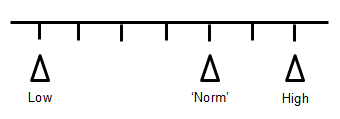At Chapters 1 & 2, you considered your feelings then placed them on a Minus10-to-Plus10 Scale.
You defined the "Low" and "High" ends of the range of your feelings and the "Norm":

In Chapter 3 you considered whether or not you were fully satisfied with these 3 measures of your work-feelings. If you are still reading then you are doing that because you are not fully satisfied. Also, in Chapter 4 you considered the first fundamental choice - Determine how to become satisfied with the Low, Norm, and High feelings you experience while you work.
Having completed that thought process, you decided to explore the second fundamental choice, which is:
Determine how to raise at least one of your Low, Norm, or High feelings you experience at work.
There are many ways to go about raising - improving - the feelings you experience at work. And, that is the topic of the following chapters. To help you place more detail around your feelings, refer to the Spectrum of Feelings presented in Chapter 1.
You must set a Goal for your feelings Norm. To do this you must first select one of the 3 Plus Zones:
Acceptance Zone: Plus1 to Plus4
Enjoyment Zone: Plus4 to Plus7
Enthusiasm Zone: Plus7 to Plus9
Acceptance Zone: Plus1 to Plus4
If you select this zone for your Norm then you are deciding that work is not going to add enjoyment to your life. In general, your workdays will not be uncomfortable...they will be comfortable to the extent they will, on average, at least be tolerable [Plus1] and at best be right at the border of enjoyable [Plus4]. Also, this zone must offer an opportunity for you to raise your current Norm. So, your current Norm must be no higher than Plus3 and likely Plus2 or lower.
Enjoyment Zone: Plus4 to Plus7
If you select this zone for your Norm then you are deciding that work is going to be an important and enjoyable aspect of your life. Your work experiences will not be thrilling, but they will be at least enjoyable. In general, you will not complain about work; you will regularly think about and mention the positive things you experience at work. Also, this zone must offer an opportunity for you to raise your current Norm. So, your current Norm must be no higher than Plus7 and likely Plus6 or lower.
Enthusiasm Zone: Plus7 to Plus9
If you select this zone for your Norm then you are deciding that work is a major aspect of your life. Work will be self-actualizing. Work will offer some of your most-positive life experiences. Work will be exciting. You will be inspired by work....and everyone who works with you will know it. Also, this zone must offer an opportunity for you to raise your current Norm. So, your current Norm must be no higher than Plus8 and likely Plus7 or lower.
So, when you think about the way you want to feel about your future work...which Plus Zone do you select for your Norm:
Enthusiasm Zone? or Enjoyment Zone? or Acceptance Zone?
Answer: my Norm will be in the ________________ Zone.